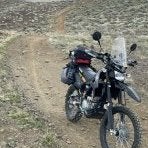
STAY WARM! How to Ride Longer and Further Into the Season
As the Summer turns into Fall and the leaves signal that snow isn’t too far off, many riders will put away their bikes until Spring…but what if you could ride longer, squeezing in valuable seat time while Mother Nature does her best to convince you otherwise?
Whether you’re an off-road, dual sport or street bike rider, we’ve spent some time talking to industry experts and experienced riders about how to gear up when it gets cold out.
OFF-ROAD
Off road riders have a limited selection of gear to help keep warm when out on the trails or track. First off, when we ride motocross, we don’t tend to wear anything extra gear-wise when competing because of the abundance of body heat generated. But there are still options for motocross/enduro/hare scrambles riders including and goggles, thermals, gloves and socks. From top to bottom let’s see what’s smart.
Head and Face
When keeping your head warm, nothing works like a balaclava. I personally find these way too hot to wear while riding MX or trails but some riders swear by them. I’d recommend that if you try this method, you use the lightest weight balaclava that fits well under a helmet - like the Terramar ThermaSilk or Fair Isle Yowie (which can be used to make a number of garments like facemask, neck warmer, etc. and it wont freeze on you when you drool on it).
One good thing about these items is you can easily pull them down and out of the way if your core temperature gets too high…and the head is where a tremendous amount of heat will escape. Many times we’ve stopped as a group of riders and when the helmets come off, the rider’s body heated moisture can easily be seen escaping off the top of the head.
While talking about your noggin, I’ve never seen anyone use a specific “winter helmet” for off-road riding, so you’re on your own there, but I have seen some goggles that are specifically made to be used during the cold weather such as the Oakley Ambush Snow and the Smith Turbofan which has a small fan in the goggle (I’ve used these and they work!) These goggles feature anti-fog coatings and dual lenses, all designed to keep from fogging when you’re riding. Remember that your breath is your enemy while riding in the cold, the differential between the outside air and your heated breath is huge - and this makes any type of eyewear fog up, especially prescription eyeglasses…so try to use contact lenses if you have them.
Thermals
This is one solution that seems to be popular among many riders and even some cold-weather racers and this segment is filled with many high tech products that crossover to other outdoor sports like skiing and snowboarding. It’s important to use the right type and stay away from old-school cotton thermals…as they get wet and never dry out, making you even colder when you stop.
Most high tech thermals use polyester and nylon for wicking sweat away from the first layer of your body and also feature elastin and spandex to give some stretchiness. We suggest using the microweight or lightweight offerings only unless you’re riding in the Arctic Circle.
Vests
Riding vests have been around for years and because they concentrate warmth specific to your body’s core area while not being bulky, they’re very popular among the off-road crowd. Passive vests are the choice for motocross and off-road riders as they don’t require a power source on the machine itself or any batteries. Some of the options here include the KLiM Torque and the Moose Expedition vest(s).
Gloves, Liners and Hand Guards
Wearing a heavier, bulkier winter type glove just isn’t an option when riding motocross, where you need precise control over your machine. To solve this, we use a glove liner with a regular non-vented motocross glove – both Under Armour and PolarTec have many selections in this regard and it’s best you try them on before buying, as fit is important.. This provides the ultimate in control, but other riders tend to use a heavier glove made for this purpose like the Fly Racing Title Long glove or the KLiM Inversion Pro.
Stopping the wind is essential in keeping warm and hand guards serve that purpose as well as deflecting branches and protecting levers and controls. Look for larger hand guards such as the MSR Hand D-Flectors and if you want the ultimate in protection in this regard, look at a gauntlet type guard such as the Powermadd Star Series which features full coverage of your hands while operating the machine.
Boots and Socks
I like wearing motocross boots and wouldn’t consider wearing anything else while on my off road bike, and because of this I have a pair of boots that’s one size larger that I wear in the cold weather. It’s a bit larger to accommodate a sock liner and bulkier sock and still leave room for your feet to move around a bit in the boot…this is important to avoid moisture building up and also keeps the blood flow optimal to your feet, keeping them warm.
Heat Sources
Some riders use a much more directed method of applying heat and this is through the liberal use of those little heat packs. These little bags of iron powder, water, salt, activated charcoal and vermiculite heat up through an oxidation process, and can produce heat anywhere from 100°F to 180°F for duration of up to 10 hours. Some riders use these items in their boots, gloves and I’ve seen riders using the heat belt type as well to keep their body core at optimal temperature.
DUAL- PURPOSE and STREET
As opposed to motocross/enduro riders, when it comes to products to stay warm while riding your street and dual purpose bikes, the options are limitless…street riders tend to get much colder than off-roaders, due to the wind chill at higher speeds, coupled with the fact that they don’t move around as much as off-road riders do. Wind is your enemy when riding on a streetbike, because it sucks away any heat you produce and is always working to cool you down. We can’t look at every conceivable option, but from top to bottom let’s see what’s smart.
Head and Face
Helmet fit is crucial when riding in the winter because wind tends to seep in everywhere when it’s cold. We have a number of helmets here and we used two during this testing, one is the Bell Star and the other the ICON Airmada. While the Star is very lightweight with incredible venting, the air gets in everywhere…our Airmada is a tighter fit and just this small difference keeps out a lot of the cold air when we ride, so use the best fitting helmet you have in your arsenal to stay warmer and make sure the vents are closed when at speed.
Keeping your shield fog-free is very important and riders address this issue in a number of ways. Many shields come with anti-fog treatment applied but I’ve never found this to be very effective in the long term. I use the old fashioned Cat Crap anti-fog treatment on my shield and find it works excellent. Keeping your expelled breath deflected from the shield is half the battle and some helmets and balaclavas can work together to help with this with problem, so look for a higher nose piece on the interior of the helmet and a specific area where you expel your breath on the balaclava. Despite all these precautions, you may need to vent the mouthpiece of your helmet, or raise your shield manually when you stop.
We’ve read that some (insane) riders use a heated, dual visor snowmobile helmet and although this may sound comfy, we don’t ride when the roads get ice on them so we just aren’t in a position to test this out.
As described above, balaclavas are the “hot ticket” for this application and many models are available. We suggest you use the full length models with extra wind protection in the chest and throat areas as this is where you are the most vulnerable to the wind getting in as long as your helmet fits well. We’ve recently tried a few of these here at the office and we liked the Dainese Windstopper and for the ultimate head roaster, try the Arctiva Dickie, it extends well into the chest area.
Thermals
When selecting some thermals for your street ride, we’d like to stress that those cotton old school thermals are not optimal as your base layer, but the new polyester/silk blends perform the important wicking functions that we know are important to stay in the saddle longer when it’s freezing out.
We’ve used the KLiM Defender base layer with much success, staying toasty and warm even when the temps have hovered around 37 degrees (before wind chill is calculated). We also talked to riders who have been using the Dainese Map Windstopper Pants and they love them although quite pricey at almost $100.
Jackets and Vests
When looking at street and dual purpose jackets for the cold, we didn’t find any significant differences so we’ll group them together. One feature that rings clear again and again is layering of your jacket components, see end of this article for a better explanation.
We tested two jackets made specifically for cold weather riding they have different features and price points.
In the more economical category (under $200) was the Joe Rocket Ballistic Revolution Jacket. It’s a two-piece water resistant jacket with a removable, water resistant insulated liner (we rode in the rain and it never leaked), armour in the back, shoulder and elbows, with a two-way main zipper with storm flap, nine pockets and lots of reflective stripes. It also has a MP3 port as well as a comfy fleece lined collar with a Velcro closure at the top of the neck. It has a lot of sizing adjustment belts and straps…many of our staff took a ride in this jacket and amazingly it was adjustable enough to fit all of our riders here and everyone liked it.
We rode in the freezing morning and evening cold, in the rain, the heat, you name it. This jacket stood up to all the bad weather (and good) that we could throw at it. The removable liner was the high point and made this jacket not only warmer, but addressed our layering concerns while providing a way to use the jacket when the temps rose…we just took out the liner and stashed it away.

Photo: Joe Rocket Ballistic Revolution Jacket
Next up was the KLiM Overland Jacket which was higher priced (under $450) but also feature packed with some very high quality construction which didn’t go unnoticed by our staff. It has a two-piece waterproof (as opposed to water-resistant) jacket that has a plethora of features and provides you with both your mid-layer and outer layer garment.
We used the KLiM Overland jacket as part of the layering system that KLiM recommended to keep us warm and dry. The Overland jacket was the most comfortable we’ve ever used for this application. The venting system on the Overland was very effective and incorporates two large vents both in the front and rear panels, reflective hi-vis striping, CE certified shoulder, elbow pads and back protector. The multitude of weatherproof pockets wasn’t as abundant in this jacket as others in the segment, but there is a very cool MP3 port in the chest pocket!

Photo: KLiM Overland Jacket
We rode in all different weather in this jacket, from 37 to 65 degrees and surprisingly it was never too hot or too cold. Only when we wore the Defender base layer in over 50 degrees did the sweat level outstrip the ability of the base layer to absorb.
The Torque insulated mid-layer jacket plays an integral part in the design and overall execution as doubles as a stylish jacket on its own. Many times we arrived somewhere and just removed the outer shell, keeping the Torque jacket on by itself and this proved very comfortable as well as convenient

Photo: KLiM Torque Mid Layer Jacket
Pants
Winter riding pants are one item that we didn’t get to test extensively as the offerings are best paired with the correct jacket. Many jackets have matching pants that zip into the jacket and we’d recommend buying the jacket first with this feature in mind, as you can always add the pants later. Remember how important durability and waterproofing are in pants as they take a lot more abuse than jackets and are closer to the road spray, dirt, gravel and mud…so get the right pair for the job.
Gloves
Passive gloves for cold weather riding are always a trade-off, you sacrifice control for warmth. In the past, the warmer the glove, normally the bigger it was. But this is changing quickly and there are many good options and techniques available today.
The first one we like is using glove liners paired with your everyday (not vented) street gloves. We’ve found this method to very comfortable in moderately low temps. We’ve used the Fieldshear house brand glove liners with great success. You can also purchase heated glove liners that allow you to pack in even more warmth but we’ve never tried them so we can’t comment on how much more effective they are.
The second method we like is a heavier winter glove with no electrics, like the KLiM Caldera or the Racer Gloves Advanced Gore-Tex glove which features new 2 glove-in-1 technology so you can dial in both your grip and warmth levels with 2 separate insulation chambers. The “grip” chamber puts insulation above your hand for warmth and feel. The “warm” chamber puts much more insulation around your hand to provide maximum warmth.
Another popular way to keep your hands is electrically heated gloves. These are all the rage these days and why not? They offer instant warmth when needed and both bike powered and battery powered models are available.
Talking with riders about these gloves and then same name keeps coming up. Gerbing have been making this cold weather gear for over 30 years so it’s safe to say they’ve figured it out. One glove that riders really like is the Gerbing EX glove. It’s a 12 volt glove that is powered by your motorcycle and it heats up to about 135 degrees!
Another popular glove in this segment is the FirstGear Heated Carbon gloves offer a bit more racer styling with prominent knuckle protectors and these also are powered from your motorcycle.
One thing to keep in mind with these types of motorcycle-powered gloves is that using a heat controller is always recommended so you can prevent overheating and battery mishaps due to user errors.
Vests
Riding vests are also available in passive and heated units. We prefer to use a passive system like the KLiM jacket with a mid-layer jacket as opposed to a vest. Why? Because we believe that although very warm, these vests tend to interfere with the airflow needed for correct sweat dissipation that is engineered into these jackets and this makes you sweat even more…and then get cold…then the vest gets turned up again. Some riders swear by them but we firmly believe that a well engineered jacket will keep you warmer and more comfortable for a longer period of time.
Windshields
Sometimes one of the hardest problems can be solved by a most obvious solution. You want to stay warm? Then consider a windshield because when you want to stay warm you have to block the wind…and we don’t mean one of those tiny sport windscreens that cover your gauges…we mean the big old Plexiglas things. Some riders just hate the look, but fairings offer a huge amount of protection from not only the cold wind, but rain as well, and staying dry is key to keeping warm…not to mention it’s easily removable when it’s warm out again.
Popular windscreens that are available include the Memphis Shades and SlipStreamer brands and most are priced at around $150 - $200 which is a real deal for the amount of protection they offer. Most come with simple mounting hardware and we easily installed one in under an hour. It’s an incredible, immediate and dramatic improvement if you want to ride in the cold weather.
Heated Grips
Another ingenious way to keep your hands warm is using heated grips. We first used these when riding snowmobiles, and it allowed us to ride using a thin motocross glove even when temps were well below freezing. And the same benefit can be had on your motorcycle. This technology is easily retrofitted to you r bike and to see how they worked we tried out a pair of heated grips from Oxford Products, as many riders we spoke with use and recommend these units.
The model we used was the Oxford Heaterz Premium Grips, which came as a complete kit ready to mount on our test bike. These grips come in every handlebar size and this model came with the integral heat controller which allowed us finite control over the grip temperatures. Installation was really easy, took about an hour and they work just like the stock grips, except they’re toasty warm!
The units fire up and get warm almost as soon as you turn them on and it’s easy to keep them right at the temperature you need, we even adjusted them while riding. They can get really hot if you don’t pay attention (up to a claimed 122 degrees) so the controller is a must with this type of item.

Photo: Oxford Heaterz Cruiser Grips
We were impressed with the Oxford Heaterz grips, they’re rainproof and use a soft rubber for better feel, and on days that weren’t as cold, we used a lightweight street glove for better control and less bulkiness with excellent results - our hands were never cold. Then when it did get colder, we switched to a heavier, gauntlet type glove which also worked out perfect. This is a highly recommended item for anyone serious about riding in the cold weather.
In conclusion, there are a myriad of products available to keep you warm while riding and to help you ride longer into the season no matter what your budget. Layering is the key. We never recommend riding when temps are close to or below freezing as black ice is a huge danger and always remember to stay extra vigilant for obstacles, as cold tires don’t grip like they do in the Summer.
Primer: Layering and Why It’s Important
In the past, keeping warm was an exercise in putting on as many warm clothes as you could and still reasonably operate your motorcycle. This method has huge drawbacks such as overheating, no sweat dissipation, bulkiness and weight, not to mention it is wholly ineffective for riders in any discipline. But this has all changed as space age fabrics and techniques have proven that layering with intelligent fabrics…
Mark Kincart from KLiM gave us some advice about layering in the winter and staying warm using their Overland jacket. Layering in the winter and staying warm is all about transportation of the bodies sweat off the skin. You sweat even when it’s cold. So the first “Defender” base layer is your transport layer. When you look at the fabric on the inside you will see raised pillows of material. These allow circulation of air and provide a large surface area for the moister to transport off the body.”
Once it’s pulled into the garment and off your skin you set it up to be evacuated through the “Torque” mid layer provides loft and insulation for the really cold days. This provides not only breath ability through the jacket but the ability to control the heat loss through venting which happens to line up with the venting on the outer shell.
Last is the outer layer comprised of the actual waterproof jacket (Gore-Tex shell).
High-humidity air between your skin and thermal is always trying to escape to somewhere cooler. The wicking action happens when sweat and moisture move across top the fibers but not absorbed…it escapes to the outside through the tiny holes in between the fibers.
So remember, don’t just stack up clothes on top of clothes without thinking about where the heat and sweat will go…and how you’ll get rid of it. You have to get that sweat off your skin and clothes…and then dry it by venting to the outside.






Recommended Comments